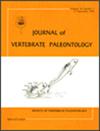来自马达加斯加上白垩纪的一种大型淡水chanid鱼(Ostariophysi: Gonorynchiformes)。Krause, D. W.(2023)马达加斯加上白垩纪的一种大型淡水樟子鱼。古脊椎动物杂志。https://doi.org/10.1080/02724634.2023.2255630
IF 1.9
4区 地球科学
Q2 PALEONTOLOGY
引用次数: 0
摘要
从马达加斯加西北部Mahajanga盆地淡水上白垩世(Maastrichtian)沉积物中分离出的化石骨骼被鉴定为属于一种淋病鱼。代表同一骨的多个元素,包括骨包、颏部、额部和基枕部,表明只有一种淋针状骨存在。最具诊断性的元素在这里被命名为一个新的属和种,†Vango fahiny;其他元素可能属于同一分类单元。马达加斯加gonorynchform材料与Chaninae亚科成员具有相同的特征,并被分配到该组。它与现存的遮目鱼Chanos Chanos相似,但通过许多特征可以很容易地将其与遮目鱼区分开来,例如基本枕部和上颌骨比遮目鱼的相对较短,耳圈整体更圆,耳突更短。马斯特里赫特群岛马达加斯加岛的一种chanid的出现很可能代表着一种海洋谱系入侵到淡水中。先前已知的白垩纪淋病虫化石分布在中纬度至北部的特提斯海,从东部(如黎巴嫩、欧洲)一直到西南部(如墨西哥、巴西)。†Vango faniny gen. et sp. 11 .代表了东冈瓦纳地区最早的中生代/古近纪淋病虫记录,主要包括南极洲、澳大利亚、马达加斯加和印度次大陆。我们感谢马达加斯加共和国矿业部、高等教育部和文化部以及塔那那利佛大学进化保护研究所允许我们在马达加斯加开展研究,感谢马达加斯加热带生态系统保护研究所以及贝里沃特拉和金科尼湖研究区的村民为实地工作提供后勤支持;A. Lownsdale, K. MacKenzie, S. Pevsner和S. Swenson协助编目标本;以及B. Rakotozafy在马达加斯加名字方面的帮助。我们还感谢D. Mayrinck和两位匿名审稿人对手稿提出的建设性意见,以及系统发育编辑P.L. Godoy和处理编辑T. Argyriou的努力。本研究得到了美国国家科学基金会(DEB-9224396, EAR-9418816, EAR-9706302, EAR-0106477, EAR-0446488, EAR-1123642, EAR-1528273, EAR-1664432和DBI-2242716)和美国国家地理学会(6400-99,69400 -00,7645-04,8597-09,9057-12)以及David B. Jones基金会对DWK的资助。丹佛博物馆研究之旅由加拿大自然科学与工程研究委员会发现基金327448 (AMM)和丹佛自然与科学博物馆(DBB)的赞助人支持。samm, DBB和DWK设计了这个项目。AMM开发了手稿的初稿,所有作者都贡献了部分以及编辑。MF首先在动物群中发现了淋病形式,AMM和DBB发现了其他元素。AMM进行了系统发育分析。补充文件补充数据1:用于系统发育分析的nexus文件。补充数据2:系统发育分析得出的最节俭树。补充数据3:系统发育分析的50%多数规则和严格共识树。本文章由计算机程序翻译,如有差异,请以英文原文为准。
A large, freshwater chanid fish (Ostariophysi: Gonorynchiformes) from the Upper Cretaceous of MadagascarCitation for this article: Murray, A. M., Brinkman, D. B., Friedman, M., & Krause, D. W. (2023) A large, freshwater chanid fish (Ostariophysi: Gonorynchiformes) from the Upper Cretaceous of Madagascar. Journal of Vertebrate Paleontology . https://doi.org/10.1080/02724634.2023.2255630
ABSTRACTIsolated fossil bones from freshwater Upper Cretaceous (Maastrichtian) deposits in the Mahajanga Basin of northwestern Madagascar are identified as belonging to a gonorynchiform fish. Multiple elements representing the same bone, including opercles, hyomandibulae, frontals, and basioccipitals, indicate that only a single gonorynchiform species is present. The most diagnostic element is here named as a new genus and species, †Vango fahiny; the other elements likely belong to the same taxon. The Madagascan gonorynchiform material shares features with members of the subfamily Chaninae and is assigned to that group. It is similar to the extant milkfish Chanos chanos but can be easily distinguished from that species by numerous features, such as the basioccipital and maxilla being relatively shorter than those of C. chanos, and the opercle being overall rounder and having a shorter auricular process. The presence of a chanid in Madagascar in the Maastrichtian most likely represents an invasion of a marine lineage into fresh waters. The previously known Cretaceous fossils of gonorynchiforms are spread throughout the Tethys Sea in mid-latitude to northern regions from the east (e.g., Lebanon, Europe) through to the southwest (e.g., Mexico, Brazil). †Vango faniny gen. et sp. nov. represents the first Mesozoic/Paleogene record of gonorynchiforms in East Gondwana, comprising primarily Antarctica, Australia, Madagascar, and the Indian subcontinent. ACKNOWLEDGMENTSWe thank the ministries of Mines, Higher Education, and Culture of the Republic of Madagascar and the Mention Bassins Sédimentaires Evolution Conservation of the Université d’Antananarivo for permission to conduct research in Madagascar, and the Madagascar Institut pour la Conservation des Ecosystèmes Tropicaux and the villagers in the Berivotra and Lac Kinkony study areas for logistical support of fieldwork; A. Lownsdale, K. MacKenzie, S. Pevsner, and S. Swenson for assistance with cataloging specimens; and B. Rakotozafy for assistance with Malagasy names. We are also grateful to D. Mayrinck, and two anonymous reviewers for providing constructive criticisms of the manuscript, and to phylogenetics editor P.L. Godoy and handling editor T. Argyriou for their efforts. This research was supported by grants from the National Science Foundation (DEB-9224396, EAR-9418816, EAR-9706302, EAR-0106477, EAR-0446488, EAR-1123642, EAR-1528273, EAR-1664432, and DBI-2242716) and the National Geographic Society (6400-99, 6940-00, 7645-04, 8597-09, 9057-12), and the David B. Jones Foundation to DWK. Museum research trips to Denver were supported by Natural Sciences and Engineering Research Council of Canada Discovery Grant 327448 (AMM), and patrons of the Denver Museum of Nature & Science (DBB).AUTHOR CONTRIBUTIONSAMM, DBB, and DWK designed the project. AMM developed the first draft of the manuscript and all authors contributed sections as well as editing. MF first recognized the presence of a gonorynchiform in the fauna and AMM and DBB identified additional elements. AMM conducted the phylogenetic analysis.SUPPLEMENTARY FILESSupplementary Data 1: nexus file used in the phylogenetic analysis.Supplementary Data 2: the most parsimonious trees resulting from the phylogenetic analysis.Supplementary Data 3: the 50% majority-rule and strict consensus trees from the phylogenetic analysis.
求助全文
通过发布文献求助,成功后即可免费获取论文全文。
去求助
来源期刊
CiteScore
2.90
自引率
7.10%
发文量
58
审稿时长
4-8 weeks
期刊介绍:
The Journal of Vertebrate Paleontology publishes original contributions on all aspects of vertebrate paleobiology, including vertebrate origins, evolution, functional morphology, taxonomy, biostratigraphy, phylogenetics, paleoecology, paleobiogeography, and paleoanthropology. JVP publishes high quality peer-reviewed original articles, occasional reviews, and interdisciplinary papers. It is international in scope, and emphasizes both specimen- and field-based based research and the use of high-quality illustrations. Priority is given to articles dealing with topics of broad interest to the entire vertebrate paleontology community and to high-impact specialist studies. Articles dealing with narrower topics, including notes on taxonomic name changes (unless these deal with errors published in JVP), preliminary site reports, and documentation of new specimens of well-known taxa, are afforded lower priority.

 求助内容:
求助内容: 应助结果提醒方式:
应助结果提醒方式:


